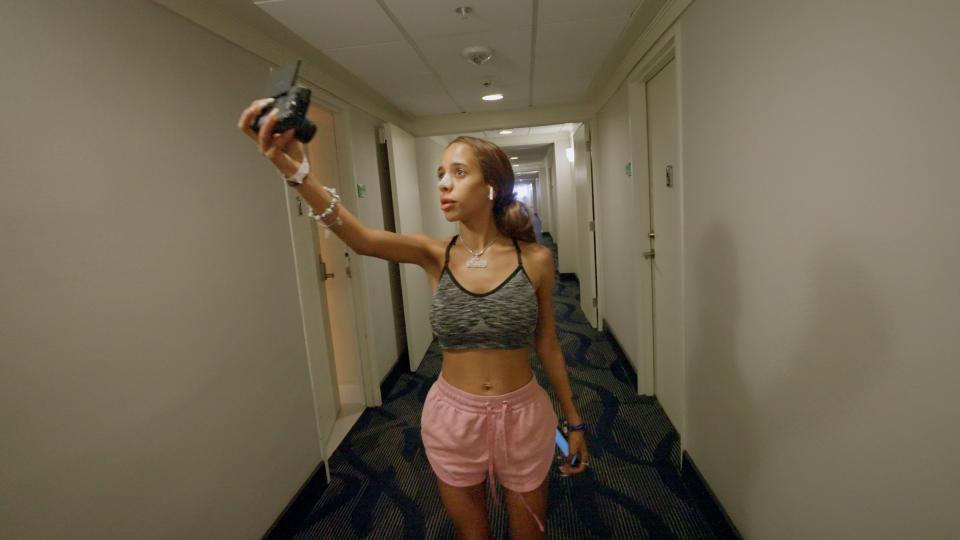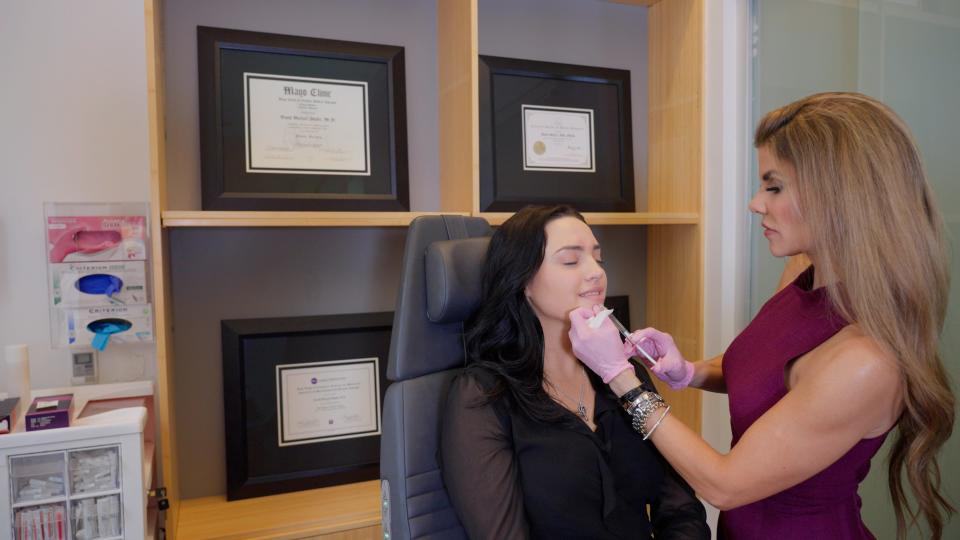Young people are documenting, recording their plastic surgery on TikTok. Here’s why that’s a bad thing.
From breast implants to nose jobs, young women across the country are documenting their cosmetic procedures online, showcasing before-and-after shots and recording the process for millions to watch. In some ways, this openness is a refreshing change from the pressure celebrities often face to lie about and deny these surgeries.
But is transparency always a good thing?
A new documentary is challenging the normalization of plastic surgery for young people. NBC News' Stay Tuned's “#FillerNation” explores the growing pressure to augment and enhance, thanks to beauty influencers on social media platforms like TikTok and YouTube.
"Any time I post about body augmentation on TikTok, (I get) at least 500,000 views," influencer Demaris Martinez, 25, says in the documentary. She says she's gotten breast augmentation, rhinoplasty and lip fillers, which she's chronicled online for her followers.

It's an effort to combat unrealistic beauty standards with honesty, Martinez says. But as more influencers showcase their new appearances – without disclosing the risks of these procedures – they may be perpetuating a cycle of ignorance and promoting an unattainable beauty standard, experts warn.
"It's nice that more people are being open about their beauty work, showing it doesn't come naturally," says Dana Berkowitz, associate professor of sociology and women, gender and sexuality studies at Louisiana State University. However, she worries "others will see this type of content and feel they, too, have to do this,"
Bella Hadid got a nose job at 14: How young is too young for plastic surgery?
What influencers aren't showing you about fillers, plastic surgery
Dr. Dendy Engelman, a board-certified dermatologic surgeon, says her patient demographic is getting younger and younger. Botox, typically used to address fine lines and wrinkles, is now common among 20-somethings and even teenagers.
According to the American Society of Plastic and Reconstructive Surgeons, nearly 230,000 cosmetic surgeries were performed on those ages 13-19 in 2017.
"When you have teenagers thinking they need to get these procedures, certainly that is disheartening and concerning," Engelman says. Some of her patients have even requested injectables in order to "feel pretty" or "be happy." In these cases, she declines their requests.
Social media and influencer culture are partly to blame. In comparison to A-list celebrities, these young and seemingly ordinary online stars appear more authentic, relatable and therefore trustworthy.

However, “#FillerNation” also exposes a lesser-known reality: Many of these influencers said they received thousands of dollars worth of cosmetic surgeries for free, or at a discounted price, to market to their audiences – without having to publicly disclose the transaction.
“To assume that influencers can demystify plastic surgery and empower their followers to make informed choices? That assumes that the influencers have the knowledge base in order to do that," NBC tech and culture reporter Kat Tenbarge says in the documentary. "In most cases, influencers don't. By leaving it up to the influencers, you're perpetuating a cycle of ignorance and also misinformation.”
NuFace, Frownies and face tape: Our obsession with at home Botox and what it says about us
Potential risks and side effects of Botox include swelling, superficial discoloration of the skin and drooping. For fillers, infection, migration of the filler and nodules or lumps are among the risks. But young adults tend to fixate on the immediate desired results over these possible, long-term consequences, says Elizabeth Daniels, associate professor of Developmental Psychology at the University of Colorado Colorado Springs.
"We're talking about people who don't have the full cognitive architecture to really evaluate the range of issues that you should consider before having a cosmetic procedure," Daniels says. "And the fact that more people are having these procedures without fully understanding the risks feeds into this unrealistic appearance culture."
"I wish I had someone to tell me, 'No. Don't get more filler.'"
Beauty standards are constantly changing, yet they stay unrealistic. But now, experts also worry about how normalized it has become for teenagers to turn to more invasive measures to feel "beautiful."
"Surgeries have been around for quite a while, but it was mostly done by middle-aged women," Berkowitz says. "Now with social media, the advertising is so much more invasive and ubiquitous, marketed to younger and younger girls."
The images and videos we're exposed to on screen have real-life consequences. Research shows that teens between the ages of 13 and 19 are especially vulnerable to peer pressure and more likely to hold an unhealthy fixation on physical beauty, which may drive some to get procedures that they will later regret.
A few influencers have admitted to going too far. In “#FillerNation,” social media star Ashly Schwan, 25, says she regrets getting free lip filler every few months after it started to migrate into her upper lip.
"I wish I had someone to tell me, 'No. Don't get more filler,'" she says.
A disclaimer or list of educational resources may be helpful for these viral videos. But at the root is a more persistent, lifelong pressure for young teens to conform to impossible beauty standards. If you don't naturally look a certain way, you're encouraged to alter yourself under the knife or needle, rather than embrace it.
But instead of modifying ourselves, it's the cultural message that needs to change, Daniels says.
"We should be encouraged to celebrate the differences and think about beauty more broadly. There is no one way to be beautiful."
Celebs often deny their plastic surgery: Why that's problematic.
This article originally appeared on USA TODAY: TikTok videos show plastic surgery, Botox, fillers; teens are watching
Solve the daily Crossword

